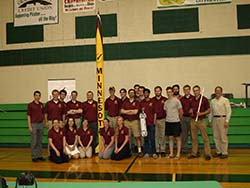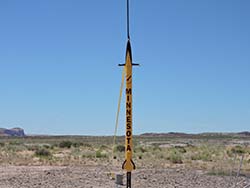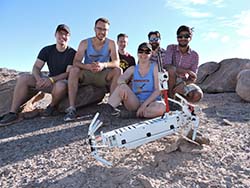Rocket Team returns from the IREC with two awards and new perspectives
 |
 |
 |
The University of Minnesota Rocket Team was one of 52 teams from around the world competing in the Intercollegiate Rocket Engineering Competition (IREC), held in Green River, Utah from June 15-18. The competition, which is sponsored by aerospace powerhouses such as Orbital ATK, SpaceX, and Aerojet Rocketdyne, is hosted by the Experimental Sounding Rocket Association. The ESRA is a non-profit organization committed to fostering and promoting engineering knowledge and experience in the field of experimental sounding rocketry.
The University of Minnesota Rocket Team is proud to announce that they received two awards at the IREC—for Team Spirit and First Place Payload, and finished 16th out of 44 teams competing in the basic competition category. Student teams competing in the IREC basic category must design, build, and launch a rocket carrying no less than ten pounds of payload to a target apogee of 10,000 feet AGL. A judging panel evaluates competitors based on the quality of required documentation, a poster presentation delivered at the IREC, their project's design and construction, and finally the system's performance on launch day.
In addition to the basic requirements of the IREC, the Rocket Team also responded to the optional technical requirement of producing a meaningful payload. This challenge was levied by The Space Dynamics Laboratory (SDL) of the Utah State University Research Foundation, because, in the words of the SDL, “there’s no reason to launch a rocket unless there’s a payload!” Rocket Team treasurer, Stephanie Wegner, describes, “Our payload was a semi-autonomous rover that several members of our group designed and built.” The team’s efforts paid off, earning them the SDL Payload Challenge First Place Award, and a $700 cash prize.
Wegner commends her fellow teammates on a job well done preparing for the competition flight. She says, “Members have worked hard all year on various aspects of our final rocket, some of which included a reefed parachute, live telemetry, pitot-static system, and student built composite body tubes.” On the day of the competition flight, “the team spent Saturday morning preparing the rocket and ended up taking it out to the launch pad in the early afternoon. The Utah heat was not forgiving,” Wegner said, “but luckily we painted the rocket a lighter color this year, and according to our data the inside of the rocket peaked around 120 degrees Fahrenheit.”
The team was able to celebrate a successful ascent in the competition flight, as the rocket flew toward 10,000 feet! However, Wegner recounts, “The way down was just as quick—no parachutes deployed and the rocket landed ballistically in the desert. We were able to find where it fell, which made for an interesting recovery. It landed nose first and compacted the rocket from 13.5 feet long to about four feet long. Pieces of the rover, avionics bay, and shattered body tubes were saved and brought back to campus. The ejection charge canisters, which contained two redundant black powder charges for the parachute to eject at apogee, were found with black powder still in them. This tells us that our charges never fired to create the explosion that splits the rocket at apogee.”
Although the Team is not positive as to why their rocket didn’t deploy its parachute, they learned a lot throughout the competition and school year. Wegner says, “We’re already starting to prepare for next year with ideas and improvements, and are excited to grow our team and gain new perspectives. We consider this year an overall success, and are humbled to have received two awards that represent the hard work and positive attitude we strive to achieve.”


